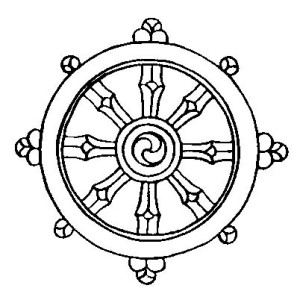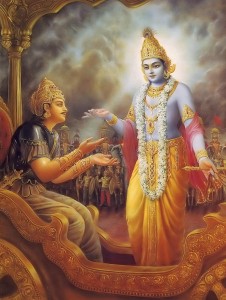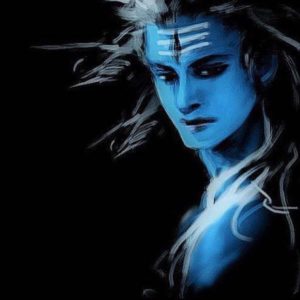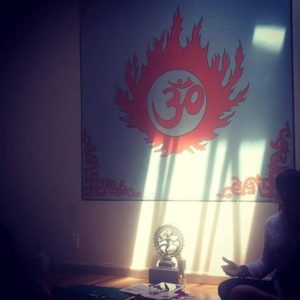
You will notice that the holy books of Yoga, such as the Upanishads, the Gita or the Yoga Sutra, are very big on outlining certain intentions, specific goals: they are praising, describing and instructing on how to attain the goal of Self realization, and how to live an awakened life.
In the yoga canon there is something called the “chatur purusharthas” : the four objectives of life. They are Dharma, Artha, Kama and Moksha. Dharma is righteousness, Artha is opulence, Kama is pleasure, and Moksha is liberation. Today we will be considering Dharma.
Classically, the term dharma refers to law, righteousness, duty. But more deeply it literally means that which upholds, firmly supports.There is a saying from the Mahabharata: “Yato dharmastato jayah”: Where there is dharma, there is victory. Dharma upholds the natural order of things. And the first, foundational purpose of life is to uphold dharma.
We all depend on dharma. It is the dharma of a driver to stop at a red light, and to go at a green one. When an immune cell in your body does its dharma, it protects your health; when it does not do its dharma, like attacking healthy cells or failing to identify pathogens, problems result.
In the Bhagavad Gita, Krishna makes a really interesting statement: “Better one’s own dharma imperfectly performed, than the dharma of another done well… the dharma of another is fraught with danger.” (3:35) The word he uses for “one’s own dharma” is Svadharma. Svadharma is your calling and doing what is in alignment with your unique nature.
When it comes to what we do in asana practice, one can easily see that “the dharma of another is fraught with danger” because if you try to model your postures on the poses of someone else, you are apt to get injured. So much of the precision of a yoga asana is for the purpose of self-listening, not for producing a showy pose or demonstrating impressive feats of flexibility. Asana practice is a way of discerning our personal truth: exactly where is my natural center? What are my capacities and boundaries at this moment? Every muscle has its dharma, and in yoga we discover that through practice.
Our svadharma is our calling, and we are purely listening to our own unique vibration when the body becomes like a tuning fork through the symmetry of the poses. We are listening for our calling. We can periodically ask what our purpose is in life, but we can also recognize that whatever our vocation is, we are called to be fully here now at this moment. Right here and now is where you are being called to be, and our dharma is always to awaken to the preciousness of this moment. The dharma of a yogi is to use the present moment to penetrate the eternal.
A symphony would be ruined if the violin refused to do its svadharma and instead played the notes intended for another instrument; it is a service to the world to tune into one’s own nature, svadharma, and to understand it. Knowing yourself and being totally yourself is your dharma. It means being comfortable in your own skin.
Dharma also means ‘doing the right thing’ which isn’t always so easy. We have all kinds of needs and impulses that don’t seem easy to combine with what is righteous. And Krishna has something to say about this too: “A person acts according to his material nature – even a wise man does so, what does repression avail?” We have needs and desires according to our human nature, and we are asked not to repress them, but to channel them. Krishna advises offering actions to the Divine. “By offering all works arising from your nature, you can purify even the most obnoxious deeds.” So it is no problem to offer a noble act to the higher Power, but here Krishna is saying to offer all acts. Dont hold back, offer everything. That is your dharma.
St Theresa of Liseux, called “the little flower”, who died when she was only 24, had a great impact on the world, and she was just a simple girl. She wrote about her spiritual practice and what she called her “little way.” She basically said quite truthfully that she was nothing special, didnt have the fortitude to be a martyr, or the brilliance to be a scholar, but that she could accept her insignificance and offer that to the universe with love. She said in the garden of the universe she wasnt called to be a rose, or a lily, or a majestic tree but could be totally at home with her small and unspectacular life by living it with love, and just deeply being herself as God made her. And she recommended doing the smallest act with consummate love.
I remember my doorman, whose name was Orlando – he was the most joyful person, and did his job with such love and positivity, that he could totally change your day. He was one of the most unforgettable characters i have ever known, and he had a great impact on the world. No matter how modest it may be, doing your svadharma with extraordinary love will make you spiritually great.
Yoga is a system that makes us get to know all sorts of things about ourselves, it’s all about going beyond our surface, getting past the facade. We get to know our body and even the deeper layers of our consciousness, instincts, impulses, desires and motivations, things that usually remain beneath our surface awareness. So we will do our poses right now as a way of simplifying, getting down to our unalloyed, unembellished nature, and we wont mar the experience by judging that but our purpose is to know it. We will have an encounter with our reptilian, mammalian and human qualities by reenacting our evolution through the poses, and get in touch with our true natures. We will find the equilibrium and acceptance in that nature, and offering it back to the universe, accomplish the goal of dharma.










Leave a Reply